A lot of attention is given to Aprilia’s staggeringly brilliant V4 monsters (the Tuono and the Mille), and quite often it’s smaller offerings are overlooked in the feverish rush to venerate the big boys.
But there has always been other gold to mine in Aprilia’s rich vein.
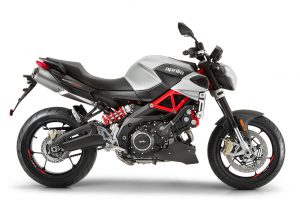
I admire very much what Aprilia has constantly done with its delightful (and now mid-sized) twins. The Shiver and the Dorsoduro have always been immensely rideable and joyous to fang. Light, quick-steering and responsive, they are simply perfect for carving European alps.
We don’t have alps here. Not really. And droning along our mostly straight, boring and heavily policed roads on either of the Shiver or Dorsoduro (or anything actually), is pretty tedious. But when you find those corners and you start hooking in…that Aprilia handling integrity…that engine note…the sheer Italianess of the bike…
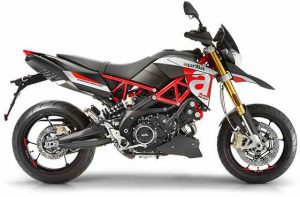
It’s a hugely heady combo.
The new same-engine paradigm has not changed this at all, and in fact, I think both bikes are better off for the capacity change.
Aprilia has now…um, rationalised them, I guess, and given them both the same 900cc fuel-injected twin OHC V-twin engine and steel trellis frame. But very cleverly, it has managed to create two vastly different-feeling bikes by changing everything else.
The Shiver is up from 750 to 900 and the Dorsoduro is down to 900 from 1200.
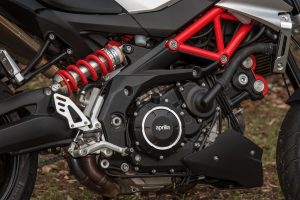 So while the frame and engine are the same, and both bikes have the same engine maps (Rain, Touring and Sport), viewed side by side and ridden back to back, the two could not be more different.
So while the frame and engine are the same, and both bikes have the same engine maps (Rain, Touring and Sport), viewed side by side and ridden back to back, the two could not be more different.
The differences lie in several crucial places.
Firstly, the swingarms and the rear shock mounting points are different, as is the suspension travel. The motard-like Dorsoduro:
- Has extra travel (up front it’s 52mm against the Shiver’s 43mm, and the rear link-free, laterally-mounted Sachs bouncer has 168mm travel against the Shiver’s 127mm).
- Is a touch lighter (212kg against 218kg), and boasts a substantially longer wheelbase (1515mm against 1465mm).
It’s also a good deal taller in the britches area with a seat-height of 905mm against the Shiver’s far less stressful 810mm. Stretch those hammies, ladies. It’s worth it.
Their final gear-ratios differ, and the Dorsoduro has a smaller petrol tank (11.5l against 14.5l).
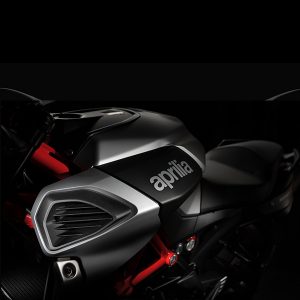 And to my jaded eye, the Shiver, as almost-handsome as it is, simply cannot hold an aesthetic candle to the visual feast of the Dorsoduro.
And to my jaded eye, the Shiver, as almost-handsome as it is, simply cannot hold an aesthetic candle to the visual feast of the Dorsoduro.
The Shiver is a mildly anodyne, well-mannered fun-bike. And the Dorsoduro is a Highway Patrol-baiting, hooligan-filth crime of passion.
Both bikes make their power, which is pleasingly adequate (70Kw and 90Nm) and not at all overwhelming, in a flat but agreeable fashion. This makes them quite gratifying to ride – especially if you’re not an A-grader with pretensions of grandeur and a demand for 200 horsies and Repsol sponsorship. In the real world, both the Shiver and the Dorsoduro deliver the goods.
These are Italian bikes that are very well appointed, with serious levels of electronic whizz-bangery and forgiveness in their souls.
Not everyone wants or needs massive amounts of horsepower and 60-degree angles of lean. And quite frankly you’re quite some massive kind of idiot if you buy a Mille Factory and you can’t ride it.
Either of these will delight you (and yes, forgive you) far more than any 200-horsepower monster.
Now you probably want to know there’s an app you can download to go with the bikes. Of course there is. Aprilia is at the forefront of this kind of technology.
So once the app’s in your phone you can find servos, admire your lean-angle, examine driveshaft torque readings, marvel at the lateral and longitudinal G-forces, and order pizza (and I made that last one up).
For some of you this will be very welcome and used often. For others, it won’t even be downloaded. But today’s world is all about choices. Aprilia provides them.
So now I have provided you with technical information, and we’ve spoken about hamstrings and pizza, it’s only right and proper I discuss the actual riding and feeling and what’s to love and what’s causing me to squint…
SHIVER 900
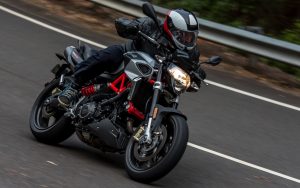
It’s all-day comfortable. The seat won’t chew on you and the riding position ergos are not at all intimidating or demanding. The clutch and brake are firm and manly, the TFT dash is lovely and easy to read (on both), except at night when the white bits are just a bit too bright. But Aprilia is hardly alone there and not the worst offender. The paisans at MV Agusta sear your retinas so badly you’ll be seeing their dashes in your sleep.
It’s slim and very traffic-friendly, the fueling is good, and that fly-by-wire throttle is well sorted. The brakes are fine, and you can always feel what the bike is doing under you. Even when you’re pushing on a bit. There’s a great deal of confidence ‘to be had in an Aprilia’s handling. They have always been great handlers, even if the earlier incarnations did put your heart into your mouth by “falling” into corners now and then. That’s long gone, and the Shiver is such a sweet bike to ride, it would almost be a shame to paint it matte black, which you must do to have any proper street cred.
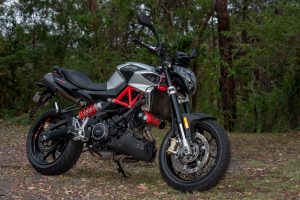
And the pipes…um, throw them away. The stock units really don’t do that great motor any favours in terms of audible pleasantness. The Shiver actually sounds a bit tinny. Clearly the terrible lash of Euro 5 emission laws is evident, but that does not apply to us beaut Aussies. Probably.
I felt it also struggled a little stylistically. It looks broad-shouldered up front with those lovely air-intakes straddling the front of the tank. And the tank is divinely sculpted. The rest of it looks a bit bitsy and aimless.
I was of course proven wrong in this view by some of my mates who thought it was a beautiful bike.
DORSODURO 900
“You’re not he boss of me, officer! Ok, you are. Please do not Taser me anymore. I have already soiled myself.”
That’s pretty much how it’s going to go on the Dorsoduro. It’s THAT kind of bike. A wonderful partner in crime. It is brutally handsome, sounds much better than the Shiver thanks to different cans – and those cans will be thrown into a river at the first opportunity and replaced by other cans, which will preferably sit much lower than these, and sound much nastier. I’m sure it’s doable despite Aprilia’s best efforts to make the high-mounted exhaust an integral part of the Dorsoduro’s design. That Euro 5 rubbish must really be starting to bite if companies aren’t treating stock exhausts as disposable items.
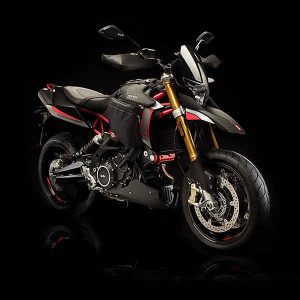
The seat is a typical motard-like abomination. “Dorsoduro” translates as “hardback”, but they’re not talking books.
It will brutalise your bottom like a stint in the English navy. It is certainly fit for purpose (ie. Motarding, running from the cops, riding down stairs, leaping off cliffs, etc), but you’re not going to bang out the big miles unless you choose to stand most of the way. And that’s fine. The stand-up ergos are pretty good.
I really thought the Dorsoduro was a beautiful bike. It is legitimately well-proportioned everywhere except at the back, where those integrated exhausts cause it all sorts of issues.
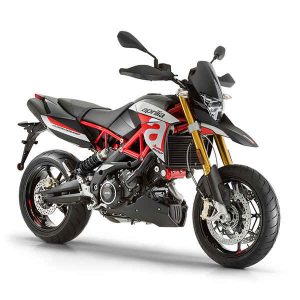 Despite my protesting hams (which I’m sure could be silenced by me doing more squats in the gym), I could really see myself having one of these in the shed.
Despite my protesting hams (which I’m sure could be silenced by me doing more squats in the gym), I could really see myself having one of these in the shed.
It would be THAT bike to me. The bike I would commit atrocities on. The bike that would end up as some dobber’s dash-footage on A Current Affair. The bike the police would call upon people to identify because they are “horrified” and “disappointed”.
I happen to like my cops horrified and disappointed.
And I very much liked the Dorsoduro.
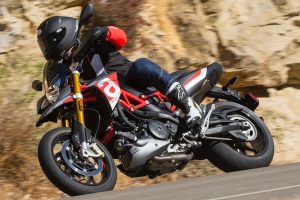
SPECIAL INSIGHTS
I think I was a touch faster on the Shiver than I was on the Dorsoduro. But that’s only because I was more comfortable.
I still prefer the Dorsoduro despite the fact its seat violated my inner thighs. I blame my thighs.
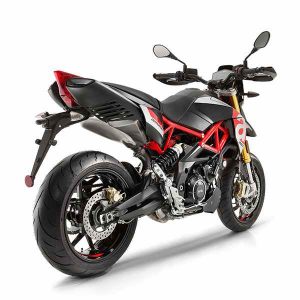
SHIVER SPECS
Engine – Longitudinal 90° V-twin engine, 4-stroke, liquid cooled, double overhead camshaft with mixed gear/ chain timing system, 4 valves per cylinder
Bore and stroke – 92 x 56.4 mm
Total engine capacity – 896.1 cc
Compression ratio – 11 : 1
Maximum power – 70 kW at 8750rpm
Maximum torque – 90 Nm at 6,500 rpm
Exhaust – 100% stainless steel 2-in-1 exhaust system with three-way catalytic converter and oxygen sensor
Alternator – 450 W at 6,000 rpm
Lubrication – Wet sump
Gearbox – 6 speeds,
Clutch – Multiplate wet clutch, hydraulically operated
Primary drive – Straight cut gears, drive ratio: 38/71 (1:1.87)
Secondary drive – Chain. Drive ratio: 16/44
Frame – Modular tubular steel frame fastened to aluminium side- plates by high strength bolts. Dismountable rear frame.
Front suspension – Upside-down fork, 41mm, with adjustable hydraulic rebound damping and spring preload.
Rear suspension – Aluminium alloy swingarm with stiffening truss, hydraulic shock absorber with adjustable extension and spring preload.
Brakes
Front: Dual 320 mm stainless steel floating discs.
Radial, four-piston callipers.
Metal braided brake hose.
Continental two-channel ABS system
Rear: 240 mm stainless steel disc. Single piston calliper. Metal braided brake hose.
Wheel rims – Aluminium alloy
Front: 3.50 X 17″ Rear: 6.00 X 17″
Steering angle – 25.9°
Tank – 15l
HOW MUCH? $15,190 plus ORC
DORSODURO SPECS
Engine – Longitudinal 90° V-twin engine, 4-stroke, liquid cooled, double overhead camshaft with mixed gear/chain timing system, four valves per cylinder
Bore and stroke – 92 x 56.4 mm
Total engine capacity – 896.1 cc
Compression ratio – 11 : 1
Maximum power – 70 kW at 8750rpm
Maximum torque – 90 Nm at 6,500 rpm
Exhaust – 100% stainless steel 2-in-1 exhaust system with three-way catalytic converter and oxygen sensor
Alternator – 450 W at 6,000 rpm
Lubrication – Wet sump
Gearbox – 6 speeds
Clutch – Multiplate wet clutch, hydraulically operated
Primary drive – Straight cut gears, drive ratio: 38/71 (1:1.87)
Secondary drive – Chain. Drive ratio: 16/44
Frame – Modular tubular steel frame fastened to aluminium side-plates by high strength bolts. Dismountable rear frame.
Front suspension – Upside-down fork, 41mm, with adjustable hydraulic rebound damping and spring preload.
Rear suspension – Aluminium alloy swingarm with stiffening truss, hydraulic shock absorber with adjustable extension and spring preload.
Brakes
Front: Dual 320 mm stainless steel floating discs.
Radial, four-piston callipers.
Metal braided brake hose.
Continental two-channel ABS system
Rear: 240 mm stainless steel disc. Single piston calliper. Metal braided brake hose.
Wheel rims – Aluminium alloy
Front: 3.50 X 17″ Rear: 6.00 X 17″
Tank – 12l
HOW MUCH? $15,790 plus ORC
Words by Boris Mihailovic
Images by Nick Edards, Half Light Photography
